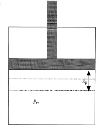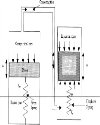
|
|
|
(3.129.15.234)
|
|
Users online: 14597
|
|

|
|
|
|
|
Ijournet
|
|
|
|
|
|
|
Dynamic analysis of a free piston free displacer split stirling cryocooler with pressure losses Jindal Tejinder Kumar1, Asst. Professor 1Aeronautical Engineering Department, PEC University of Technology, Chandigarh (India) Abstract Free piston free displacer cryocoolers in the small capacity miniature range, used for cooling infrared sensors, have a long operating life without maintenance. This paper shows the complete dynamics and thermodynamics of the free piston free displacer miniature cryocooler including the pressure loss due to the flow through the regenerator and the variation of the pressure in the bounce space. Top | Introduction The miniature Stirling cryocooler driven by linear motor does not have fixed amplitude of motion as in the case of crank driven system. The amplitude depends upon the cooler and the motor characteristics. Therefore, it becomes necessary to analyze dynamics of the cryocooler and the motor characteristics coupled together. |
Many researchers have described. free piston Stirling cryocoolers and their analysis. Bapat [1994] has done the analysis of free piston free displacer cryocooler analysis with linear motor in the ideal conditions without taking the losses into consideration. The different types of losses have been described by Chhatwal [1992], Choi [2004], Davey [1987] and Orlowska [1987]. No analysis, however, could be found out where the motor and the piston motions are coupled with losses. The present work is the analysis of the FPFD cryocooler with coupled linear motor taking the pressure losses across regenerator and in the bounce space of the cryocooler |
Top Analysis of the linear motor Bapat [1994] have described and analysed the linear motor in detail and have calculated the power input and power output of the linear motor as given below in equations 1 and 2. |
Input power to the linear motor |
Power output from the linear motor |
E0 Impressed voltage Amplitude (V) |
Es Induced voltage Amplitude (V) |
an, Bn Constants in the Fourier series hs Active coil height (m) |
Top Effect of bounce pressure variation The bounce space of the Free piston free displacer Stirling cryocooler has been considered to be at the same mean pressure throughout the cycle and the variation in the pressure due to the movement of the piston in the bounce space are neglected. The variations, however small, can affect the performance of the cryocooler. It acts as a pneumatic spring. |
Assuming the piston to be at the mean position, the mean pressure in the bounce space is the equal to the charge pressure, Pav.If the piston is displaced by a small displacement Xp, The pressure in the bounce space change to Pav+ 5P. Where 5P can be positive or negative according to the movement direction from mean position. Assuming the constant temperature in the bounce space, the spring constant can be found out to be |
Where, Vb is the volume of the bounce space |
This spring acts in unison with the metallic spring. So, the effective spring constant is the sum of both the piston and the gas spring constants and can be taken as |
Top Pressure loss across regenerator While deriving the expressions of power input cooling power and coefficient of performance, the instantaneous pressure throughout the whole cryocooler had been assumed to be same. As the regenerator causes restriction to the flow, there is a pressure loss across the regenerator, which had not been considered earlier. The loss of pressure across the regenerator can be taken into account in the form of flow loss coefficients, which is defined by Bapat [1994], While calculating the cooling power and coefficient of performance these coefficients were neglected. The flow loss coefficients are Fpc, Fde' Fpeand Fdc, |
Where, Fpc is defined as the flow loss coefficient in the compression space due to the movement of the piston; Fde is the flow loss coefficient in the expansion space due to the movement of the displacer; Fpe is the flow loss coefficient in the expansion space due to the movement of the piston, and Fdc is the flow loss coefficient in the compression space due to the movement of the displacer. The pressure loss is the product of the coefficient and the velocity of the piston or the displacer. After the consideration of the flow losses the assumptions made in the analysis of the cryocooler are as follows: |
The expansion and the compression are isothermal due to the instant mixing of the hot and cold gases in the spaces. The temperature gradient in the regenerator is linear. Heat transfer in the heater and cooler is perfect
Top Thermodynamic analysis The working diagram of FPFD Stirling cryocooler is shown in Fig. 2. The instantaneous pressures in compression and expansion spaces after considering the flow losses across the regenerator can be expressed as follows. |
Z Pressure position coefficient (Nm−3) |
Xp, Xd Amplitude of piston and displacer |
The pressure drop across the regenerator is given by |
Where, Fp=(Fpc-Fpc) and Fd=(Fde-Fdc) |
Fp and Fd are called flow loss coefficients. It can be assumed that two pressure position coefficients Zp & Zd and the two flow loss coefficients Fp & Fd are constant i.e. they are independent of the piston and displacer positions Xp & Xd and the phase shift (0) between them. |
Refrigeration effect Qeo is given by |
Putting the values of Pe and pc |
The expression for work done or power input to FPFd is given by: |
Coefficient of performance is given as |
Top Dynamic Analysis of the machine The Fig. 2 shows a schematic diagram of a FPFD split Stirling cryocooler, along with the free body diagram of the piston and displacer. For FPFD split Stirling cryocooler various force acting on the piston are Inertia force pressure force (Pc-Pav), Spring Force (KpXp) and Electro Magnetic force (Bg Iv i) by linear motor. |
The governing equation of motion is represented as |
Now substituting these values in the balance force equation 12 and comparing the coefficients of Sinβ and Cosβ and simplifying, we get |
Motorized Displacer dynamics |
Various forces acting on the displacer are: |
Pressure force acting on the displacer |
Balancing the forces acting on the displacer |
Substituting the respective values of the different forces in the balance eqn.21 and comparing the coefficient of sin α & cos α, we get |
Cross multiplying and simplifying gives |
Here also the motor phase shift (ɸ is independent of applied voltage but is strongly dependent on the resonance conditions. The displacer amplitude Xd is directly proportional to applied voltage Eo’. |
The equation of motion of displacer is |
Various forces acting on the displacer are same as derived earlier for motorized displacer except electromagnetic force. |
Substituting this value of the forces in balance force equation 30 and comparing the coefficients of sin α and cos α, we get |
Since in this case the displacer is driven by gas force, its amplitude is directly proportional to the piston amplitude and the Cosine of the phase difference. |
The expression found includes the pressure loss coefficients across the regenerator. If these coefficients are put equal to zero, the expressions are same as obtained without flow loss coefficients by Bapat [1994]. |
Top Figures | Fig. 1: Effect of bounce space pressure
|  | |
| | Fig. 2: Schematic of a free piston free displacer split miniature Stirling cryocooler
|  | |
|
| | |
|
|
|
|
║ Site map
║
Privacy Policy ║ Copyright ║ Terms & Conditions ║

|
|
|
751,572,164 visitor(s) since 30th May, 2005.
|
|
All rights reserved. Site designed and maintained by DIVA ENTERPRISES PVT. LTD..
|
|
Note: Please use Internet Explorer (6.0 or above). Some functionalities may not work in other browsers.
|